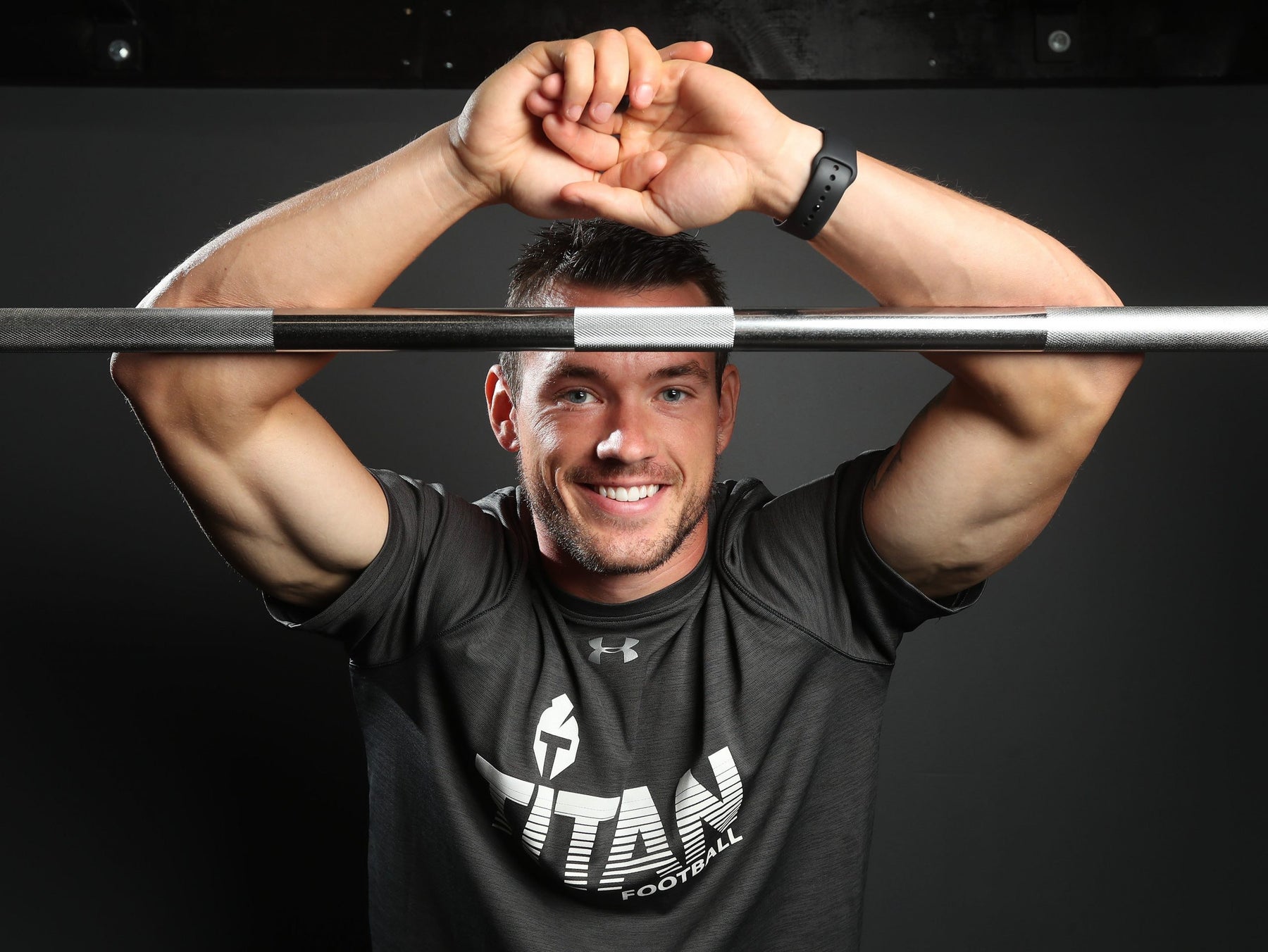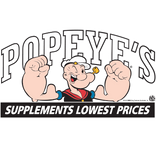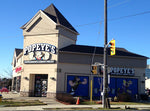
Sports Performance Training During COVID-19
Bio:
Brendan Gillanders is a 7-year Canadian Football League (CFL) veteran and is currently a running back for the Ottawa REDBLACKS. He graduated from the University of Ottawa in 2014 with a degree in Human Kinetics and has held both Personal Training (CPT) and Strength Coach (CSCS) Certifications.
Brendan works in multiple gyms in Ottawa each offseason, helping dozens of athletes reach their goal of playing university and professional sports. With the cancellation of the 2020 CFL season due to COVID-19 measures, Brendan has taken his off-season gig fulltime and now offers personal training to athletes and the adult population to help “weekday and weekend warriors” reach their fitness goals. Click the image to follow Brenden on Instagram
Sports Performance Training During COVID-19:
I was half-way through my off-season training schedule, coming off a 2019 campaign which saw me start three games at running back for the Ottawa REDBLACKS. I was determined to build on the opportunities which were granted to me late in the season and push for a large role in the offense for 2020. I was locked in, both physically and mentally and in the best shape of my life. My nutrition was on point, my training regimen (which I have programmed for myself since graduating university) was paying huge dividends as I easily matched career bests in jump (routinely executing 60” box jumps and measuring a 40” vertical jump) and sprint performances (4.47s 40-yard dash) and then it all came to a screeching halt. At the time I was training exclusively at our stadium gym (TD Place) and when we got word that the country was going into lockdown, I was fortunate our team’s athletic therapists allowed me to take home an Olympic lifting bar, 315 lbs worth of bumper plates, a 70 lb sandbag, and two 50-lb kettlebells. These would become my only training tools for the months to come.
I wasn’t about to concede all of my hard work. Approximately half of a CFL team’s roster is made up of American players who did not have the same quarantine restrictions imposed on them by their government, thus allowing them to still train. I remember saying “linebackers are not going to take it easy on me because I couldn’t train properly” and it is quite literally my job to show up physically prepared to do what my position requires me to do: run fast, jump high, and play football at a professional level. Given the recent decision to once again close training facilities, what better time to share how I emerged from a four-month gym-free period (quite possibly) a better athlete than before!
Training Regimen:
Anytime I talk about training for sports performance I’m referring to movements and athletic qualities essential to the sport. Much like competitive weight lifters or bodybuilders go to the gym for a specific purpose, sports performance training uses the gym and specific lifts as a tool to develop athletic qualities. For example, a competitive weightlifter squats to get stronger in the squat whereas an athlete might squat with various loads to improve rate of force production (RFD) which has the potential to increase sprinting speeds and jumping heights. For virtually every field sport, sprinting speed is the holy grail of athletic qualities.
Ottawa weather in March is . . . let us just say unpredictable! I ran three times per week for the duration of the stage 1 and 2 restrictions. I chose to run at a bus pickup/drop-off area of a nearby elementary school because there was still snow on grass fields and traffic would not be a concern. I continued to run at this location until the grass was completely thaw and dry enough to use (which wouldn’t be until mid-May). My sprint sessions consisted of technique work, speed, change of direction, and plyometric training. Feel free to click on the hyperlink to learn more about the exercise in question, including some of my own sprint drills.
Monday:
- Technique work: Plyometrics
- Short (0-40 yd) Linear Sprints
Wednesday:
- Technique work: Plyometrics
- Change of direction
Friday:
- Technique work: Footwork Drills (example drills)
- Longer (60-100 yd) Linear Sprints
Once I could run on grass again, my regular field training resumed and I was able to once again perform football specific drills in addition to speed and change of direction work.
As I referenced earlier, every lift/exercise in sports performance training serves a purpose. With the barbell and bumper plates, sandbag and kettlebells I was able to perform full-body lifts and favoured exercises which utilized triple extension (extension of the ankles, knees, and hips in sequence), and multiple muscle groups in hopes of maintaining as much strength and muscle mass as possible. An example of how I scheduled my weekly lifts with links to YouTube as examples of how to perform:
Tuesday:
- Barbell Power Snatches (from hang)
- Barbell Jump Squats
- Split-Squat Jumps
- Chin-ups
- Plyometric Push-ups
Thursday:
- Sandbag Power Cleans
- Sandbag Good-Mornings
- Kettlebell Single-Leg Romanian Deadlifts
- Kettlebell Split Squats (heels elevated)
- Nordic Hamstring Curls
- Kettlebell Swings
Saturday:
- Barbell Power Clean to Front Squats
- Chin-ups
- Barbell Push Press
- Barbell Romanian Deadlifts
- Walking Lunges
These exercises when used with various loads combined with bodyweight sprints, change of direction and plyometric training can develop strength, power, and speed by increasing my body’s force producing capabilities as well as rate of force development which will have a direct carryover to athletic qualities associated with any field sport.
Nutrition and Supplementation:
First and foremost, the goal for any prolonged period of restricted exercise should be preserving as much muscle mass as possible. To ensure you can retain as much muscle mass as possible, a dietary protein intake between 1.2-1.6 g/kg of bodyweight should be consumed daily. Two strategies to help increase your protein intake are to ensure that you consume an adequate amount of protein with breakfast (at least 30g) and to invest in a high-quality whey protein supplement. Whey Protein Isolates tend to be the most digestible and the most rapidly absorbed form of whey protein supplementation. In addition, they also have the highest concentration of a critical amino acid called leucine providing the greatest effect on muscle protein synthesis. For those looking to consume a protein specifically after training or any who might suffer from compromised digestion, I personally use Whey Protein Hydrolysate.
In addition to whey protein, it is important for me to use supplements which support anaerobic training as the average football play only lasts six seconds in duration. Creatine is one of the most researched supplements available and has consistently been proven safe and effective at increasing anaerobic (burst) performance. Creatine monohydrate is the most cost-effective and most researched version of the supplement. I use micronized creatine monohydrate and for dosing you can employ one of the following strategies:
- Option 1: An initial loading phase of 10 - 15g per day (one week) to reach muscle saturation and then reduce the dosage to 5g daily thereafter (fastest saturation, ideal for high performance athletes)
- Option 2: Supplement with 5g daily and you will reach muscle saturation within the first month of supplementation (slow and steady, great for younger athletes and 1st time users)
- Option 3: Some athletes or individuals with a large amount of muscle mass may be advised to take the standard dose of 5g per day followed by 5g post-workout on lifting days (middle ground strategy)
Pre-Workout Motivator:
As a professional athlete and trainer, I am very self-driven. As an added element, the knowledge that my spot on the roster can be given to someone who comes to camp stronger and faster is an additional driver to get me moving on those cold, wet mornings! Even with that, it is nice to have some added support to push me past my point of failure and for added mental focus, I use a pre-workout. Below, I have laid out some key elements you should consider when choosing one as it is important to support both your muscles and mind, and not just ingest basic stimulants! Below is a brief summary of some of the critical ingredients found inside my favorite pre-workout and what it can do to help you power through your training!
- Caffeine is another supplement that has tremendous performance enhancing benefits. A general dosage of 200-400mg taken 15-20 minutes prior to exercise has repeatedly been shown to improve strength performance in lifters. Caffeine tolerance over time will nullify the benefits of caffeine supplementation so it is advised to reduce caffeine consumption on rest days or certain periods throughout the year when training is reduced.
- Beta-Alanine when ingested turns into carnosine. Carnosine helps buffer acid in the muscular system which makes this supplement especially helpful at increasing performance in exercise bouts lasting 60-240s in range. Beta-alanine can be taken at any point in the day and benefits can be seen with a dosage of 2-5g per day.
- Citrulline Malate is a vasodilator which improves blood flow and in turn improves power output. It has been proven to reduce fatigue in both aerobic and anaerobic activities. Citrulline Malate should be taken 15-20 minutes prior to a workout and in dosage of 6-8g.
- Key electrolytes Magnesium and Sodium Bicarbonate are often found in sports drinks and some pre-workout formulas. Magnesium can reduce blood pressure, increase glucose tolerance and decrease neural excitation (potential to reduce muscular cramping). Sodium bicarbonate is a powerful electrolyte that acts as an acid buffer which can help lower the body’s pH level, reducing fatigue during exercise.
- Branched-Chain Amino Acids can help stimulate muscle protein synthesis and can help reduce fatigue by preventing serum decline in amino acids during exercise. During prolonged periods of restricted protein consumption, a 4:1:1 ratio of leucine-isoleucine-valine can help boost anabolic signalling due to the higher leucine content compared to a standard 2:1:1 ratio. For this, I use additional servings after training to support my recovery and for those looking to build, consider an EAA.
Most of the supplements above can be purchased on their own or are available packaged together in a formulation. It is important to note that although none of the above-mentioned supplements are a necessity, all have been thoroughly researched and have been clinically proven to provide the performance enhancing benefits mentioned above. I personally use every single one of the supplements to support my workouts. In situations where training is restricted, supplementation can be an extremely useful tool to enhance workouts and maintain progress.
*Brendan is a sponsored athlete with Athletic Alliance and exclusively uses their products to enhance his health, nutrition, workouts, and lifestyle. Athletic Alliance is certified for athletic use as banned-substance free, perfect for football at any athletic level.



Leave a comment